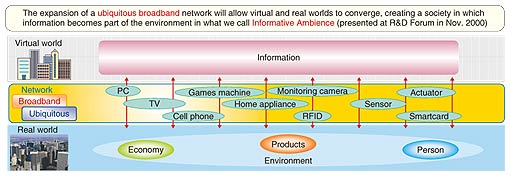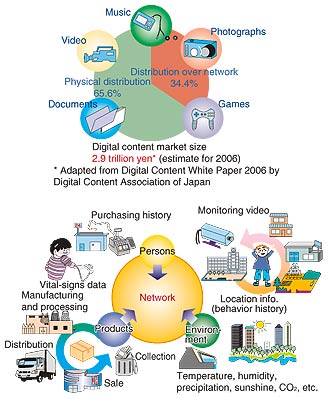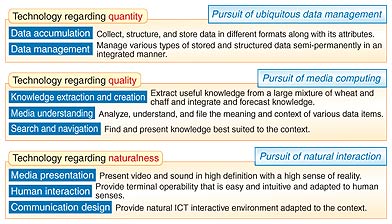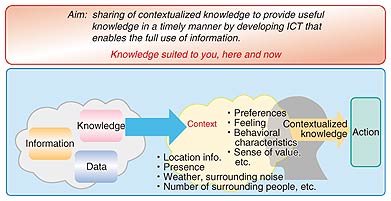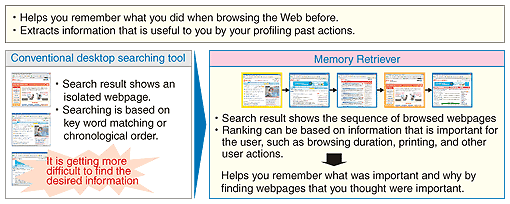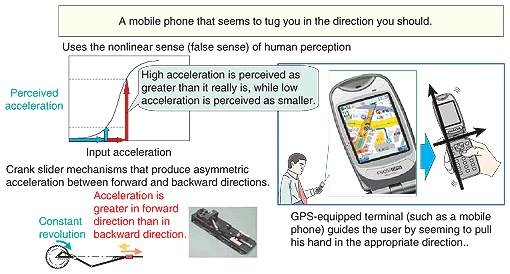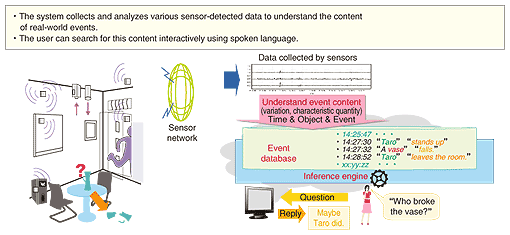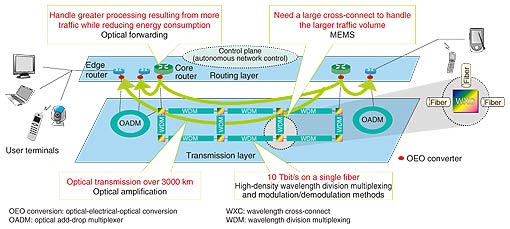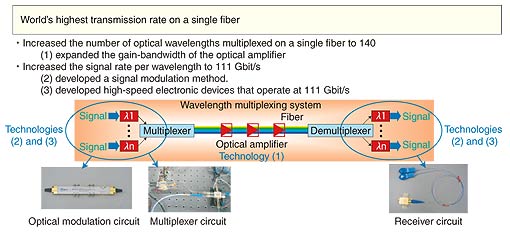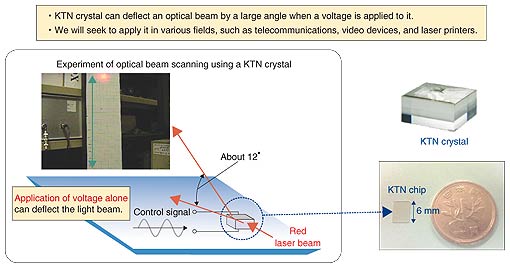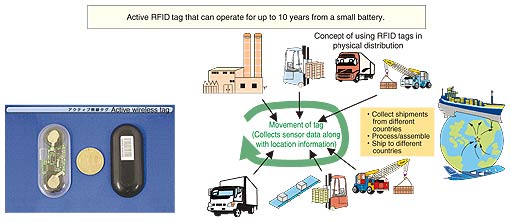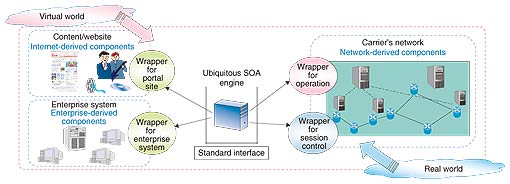 |
|||
|
|
|||
Vol. 5, No. 4, pp. 15–24, Apr. 2007. https://doi.org/10.53829/ntr200704sf2 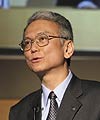 Evolving ICT and Challenges in R&DAbstractNTT is undertaking technical innovation aimed at supporting the creation of an environmentally friendly society, guided by its most recent R&D vision of sharing contextualized knowledge, which extends and supersedes the previous vision of information sharing. This article is based on the speech made by Takashi Hanazawa, Director of NTT's Department III, during the NTT R&D Forum 2007, which was held on February 8–9, 2007. 1. Progress in information sharing and the next paradigm1.1 From telecommunication to information communication and on to information sharingIn recent years, NTT has announced a series of research and development visions. In 1996, we reviewed the transition from telecommunications to information communications and foresaw the further transition to information sharing (Fig. 1). The concept of information sharing represents the mechanism of connecting people to information in order to support economic and social activities over a network. Later, in 1998, we proposed the idea that the overall information sharing platform will consist of four layers: terminals, network, platform, and applications. Our current R&D into the next-generation network (NGN) is based on this idea. In November 2000, we predicted that the expansion of a ubiquitous broadband network would allow virtual and real worlds to converge, leading to a society in which information becomes part of the environment. We chose the term "informative ambience" to describe this (Fig. 2). Our prediction of the emergence of applications in which virtual and real worlds converge assumes the widespread use of always-on connections. Today, the word "ubiquitous" appears in the government's policy, but at the time of our prediction it was not well understood, and it was not well recognized either technically or socially.
1.2 Progress in information sharingLet us review the dramatic progress in information sharing and look forward to its future from four perspectives: the availability of real information in digital form, the execution of economic activities in a virtual manner, the rapid increase in posting of information by individuals, and the penetration of high-definition and highly realistic presentations. (1) Availability of real information in digital form
(2) Execution of economic activities in a virtual manner (3) Rapid increase in posting of information by individuals (4) Penetration of high-definition and highly realistic presentations While various changes are taking place in the world of information sharing, as described above, they are resulting in some new adverse effects. Some complaints are that there is too much information, there is a mixture of wheat and chaff in the quality of information, and it is becoming difficult to exchange information in a natural manner. These criticisms imply that we are facing the problem that, while the information environment surrounding people and enterprises is becoming richer, people are finding it more difficult to use the environment appropriately and in a manner that meets their needs. 1.3 ICT to enable the full use of information (from information sharing to the sharing of contextualized knowledge)Recognizing the problem discussed above, NTT has identified the technologies needed to make information and communications technology (ICT) a tool for enabling the full use of information (Fig. 4).
First, we think that one of the important technologies needed to deal with the huge quantity of information is data accumulation technology. Specifically, we need technology for collecting data in different formats, for adding indexes to the data and its attributes indicating where and when it was collected, for assisting in data discrimination, and for structuring and storing data. We also need integrated data management technology to manage various types of stored and structured data semi-permanently in an integrated manner so that it can be readily used by services. Important technologies for dealing with the quality of information include knowledge extraction and creation technology—specifically technology for extracting useful knowledge from a large mixture of wheat and chaff, integrating multiple items of knowledge to create new knowledge, and using the knowledge to make forecasts. Another important technology is media understanding technology for analyzing and understanding the meaning of various pieces of data and creating profiles by extracting the user's context. Here, context means the situation in which the user is using a service and his or her preferences and sense of value, etc. The third is search and navigation technology for finding and presenting the knowledge best suited to the user's context. Technologies for enhancing naturalness include media presentation technology for presenting video and sound in high definition with a high sense of reality. Another is interface technology for providing terminals that are easy and intuitive to operate and are adapted to human senses. The third is communication design technology for providing a natural ICT interactive environment adapted to the particular context. NTT R&D will pursue these technologies by characterizing technologies to deal with quantity as ubiquitous data management, technologies to enhance quality as media computing, and technologies to enhance naturalness as natural interaction. We will strive to develop ICT services that draw on all these three types of technologies and provide useful information to users in a naturally interactive and timely manner. To indicate this direction of NTT's R&D, we have announced a new R&D vision called the "sharing of contextualized knowledge". This supersedes and enhances the previous concept of information sharing. The R&D into ubiquitous data management, media computing, and natural interaction is driven by the aim of bringing about the technological innovation needed to provide services for the sharing of contextualized knowledge, which is knowledge that leads to optimal action according to context (Fig. 5).
2. Innovation in service implementation technology2.1 Examples of future servicesAlthough we do not currently have any killer applications or business models of proven feasibility that could implement the sharing of contextualized knowledge, we will drive our R&D forward with specific service ideas, such as those described below.
The technology inheritance service using the five senses (Fig. 6) collects and manages multimodal data in real time, for example, about how a person's fingers move and apply force during the repair of a watch (ubiquitous data management). The service extracts the characteristics of the delicate actions of the expert from video and sensor data and turns them into knowledge or technical know-how, which can be shared (media computing). The service reproduces intuitive five-sense information, such as the expert's visual scope and focus and the delicate application of force, for a number of apprentices via special displays and gloves (natural interaction). Other conceivable service examples include a health coaching agent service, which provides dietary knowledge most suitable for a user's health by making use of essential data regarding his/her daily exercises and eating habits, and a crime prevention and tracing service, which identifies suspicious unattended objects or situations that might lead to potential crimes, or traces suspects by using a large volume of data collected by cameras and sensors scattered throughout an area. 2.2 Specific technologies being pursuedLet me introduce some examples of technologies being developed for future services.
Memory Retriever is a human behavior profiling technology (Fig. 7). You can try this out on the goo Labs website (http://labs.goo.ne.jp/). It collects and stores the history of actions on your personal computer (PC) when you are browsing the Web and searches for and reproduces the situation that occurred in the previous browsing session. The objective is to help you remember what you did before. Through this profiling of past actions and thought patterns, it extracts information that is useful to you from the rapidly expanding Web.
Buru-Navi is a force-feedback haptic interface using the characteristics of human perception (Fig. 8). Humans perceive high acceleration as being much higher than it really is, while they perceive low acceleration as being much lower than it really is. Therefore, if you hold a machine that produces greater acceleration in the forward direction than in the backward direction, you feel as if you are being pulled. If such a device can be made small enough to be incorporated into a mobile phone equipped with GPS (global positioning system), then the phone will seemingly be able to tug you in a certain direction. This haptic interface could indicate to a blind person, for example, the direction that he/she should take.
The s-room is designed to assist users to understand real-world events and their conversion into content (Fig. 9). Sensors (for acceleration along three axes, direction along two axes, temperature, luminance, etc.) are attached to various objects, and the system collects and analyzes data from these sensors in order to understand the content of real-world events. It enables the user to carry out searches interactively using spoken language. For example, if a sensor attached to a flower vase detects a certain acceleration, the system determines that the vase has fallen and records the event. Another event "Taro stood up and left the room" is recorded by sensors detecting Taro's identity via his ID tag and the movement of the door. When asked "Who broke the vase?" the inference engine infers the answer from the recorded information and replies "Taro may have broken the vase." This mechanism has been verified in experiments. A prerequisite for natural interaction is a clear video image. One issue in enhancing video quality is video coding technology that supports efficient storage and transmission. NTT has a long history of studying video coding. For example, the MPEG-2 chip that we have developed and the H.264 chip that is being used in our NGN trial are highly regarded by video technology experts. We will vigorously pursue higher definition, compression, and functionality in video coding. 3. Innovation in network technology3.1 Directions in which the communications network is developingSo far, I have introduced some services that we have been studying based on our view that information sharing will further evolve to the sharing of contextualized knowledge. The underlying foundation for such services is the network that connects the virtual and real worlds. We expect network technology to develop in three directions (Fig. 10).
(1) Pursuit of broadband performance (2) Pursuit of ubiquitous performances (3) Pursuit of agility 3.2 Backbone network that can economically handle traffic demands in the petabit/s rangeOne issue concerning the broadband network is the need to increase the volume of information that can be carried on a single optical fiber. We expect a transmission rate of 10 Tbit/s on a single optical fiber to be available on a commercial basis in about ten years time, and we hope to achieve optical transmission over 3000 km without requiring conversion into electrical signals (Fig. 11). We will also need nodes that can handle the greater processing that will result from this higher volume of traffic while consuming less energy. Although it may be difficult to develop such an optical router within ten years, we hope to be able to implement optical forwarding. We also hope to develop the large optical cross-connect that will be needed to handle the larger traffic volume by utilizing microelectromechanical systems (MEMS) technology. NTT has been vigorously pursuing an all-optical network. As we look ahead 20 to 30 years from now, we will continue to follow this path towards an all-optical network.
3.3 Current activities
We have already demonstrated an optical transmission rate of 14 Tbit/s on a single optical fiber (Fig. 12). This is sufficient to transmit 140 high-definition movies in one second. It was achieved by (1) increasing the number of optical wavelengths multiplexed on a single fiber, (2) introducing a signal modulation method that we originally developed for wireless transmission, and (3) producing electronic devices that operate at a high speed. To increase the number of optical wavelengths multiplexed on a single fiber, we increased the gain-bandwidth of the optical amplifier. This increased the usable wavelength bandwidth on a fiber by 1.7 times. Although this performance of 14 Tbit/s has been successfully verified in laboratory experiments, it may take some time before it can be introduced on a commercial basis.
One step towards the dream of optical integrated circuits is photonic crystal technology (Fig. 13). To be able to build an all-optical network, we need to develop optical memories and optical integrated circuits (ICs). This is being pursued by many researchers in the world. We have succeeded in trapping light by building a resonator within a photonic crystal. We have successfully stored light for one nanosecond, which we consider to be one of the best accomplishments in the world.
Figure 14 shows an active RFID tag, which is needed to provide ubiquitous services. It is about the size of three large coins (500 yen coins) and uses so little power that it can operate continuously (intermittent operation) for up to ten years on a small battery. Such active RFID tags can be used in a wide range of applications. We are currently conducting a field trial in which active RFID tags are used to trace the movements of containers in a physical distribution system. We have developed wireless access, modulation/ demodulation, and coding methods. Signal reliability has been enhanced to reduce the number of signal transmissions and consequently power consumption. The time needed for signal transmission has also been reduced. In my discussion of agility, I indicated the importance of the convergence of the virtual and real worlds. In the virtual world, there are many components: Internet-derived components, such as items of content and websites, and enterprise-derived components within enterprises, and new applications are created by combining these components. In this context, the service oriented architecture (SOA) is being widely discussed today. NTT is considering the idea of defining network functions and information as components and incorporating them into this mechanism (Fig. 15). We will allow information about the network running in the real world to be accessed and controlled from the outside through wrappers. Although this mechanism is easy to understand within the context of the convergence of the virtual and real worlds, there are social and political issues, such as open networking. Discussions from a wide range of perspectives will be necessary before this mechanism can actually be implemented.
3.4 R&D for the NGNThe key concepts for our NGN can be expressed by two key words: open and collaboration. The NGN is the critical infrastructure for creating next-generation services that operate in the context of the virtual and real worlds. We consider the provision of an open server-network interface (SNI) to be the first step towards the convergence of the virtual and real worlds. We believe that this mechanism will encourage the sharing of knowledge and wisdom with our partner companies and will push forward our efforts to create new services and added value. Discussions with application developers are essential in order to determine how network functions should be presented to them. We hope such discussions will lead to an improved SNI. 4. Towards a communication future focused on people and the earthI have discussed the future directions of our R&D activities. These should not result in an increase in the load on the environment. On the contrary, ICT should help to reduce the environmental load. The NTT R&D Forum 2007 introduced technologies being investigated by NTT Laboratories through special speeches and workshops with one of the sub-themes being contributing to the achievement of a safe, secure, and sustainable society. NTT aims to develop the sharing of contextualized knowledge, woven from the experiences of independent individuals, and is undertaking technical innovation to make possible a life-fulfilling, environmentally friendly society, conducive to the vibrant generation of contextualized knowledge. |
|||









